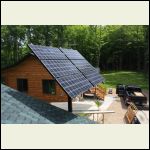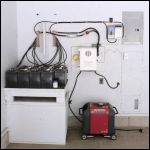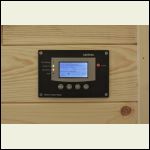|
| Author |
Message |
sam
Member
|
# Posted: 18 Jan 2011 19:53 - Edited by: sam
Reply
I'm a 24 year old college student who recently undertook the challenge of designing and installing an off grid system at my family's newly constructed cabin. I spent hours on the internet, often reading the user manuals of different products so I could gain and understanding of how to do DC wiring. The whole time I conducted my research I thought, "someone must have done this before, I wish I had their plans."
So here is a link to a blog I recently put together :: offgridcabin.wordpress.com
For anyone considering an off-grid system, especially if they are doing it themselves, I hope you can learn something (even if it is what not to do). And if you have an off-grid system, I invite your criticism. Cheers.
Some quick details:
Honda EU3000
Xantrex MS3000 Inverter with remote mounted system panel
Xantrex C60 charge controller
14x 225 Ah Johnson Control 6V batteries
6x 135 watt Kyocera solar panels
12 volt DC LED lights
f12869761.jpeg
| 
f23905281.jpeg
| 
mg_8608.jpeg
|  |
|
|
Rob_O
|
# Posted: 18 Jan 2011 21:02
Reply
I'd recommend building an enclosure for the batteries, and venting it away from the electronics and generator
|
|
sam
Member
|
# Posted: 18 Jan 2011 21:28 - Edited by: sam
Reply
Dad and I are currently considering some sort of an enclosure, but we've been a little lax about building an enclosure because it doesn't look like any small children will be at camp any time soon. While we considered the venting requirements of the batteries we figured that placing the batteries in the garage would be adequate. To be honest, I never actually found information on whether or not the batteries need venting under our set of circumstances.
|
|
MtnDon
Member
|
# Posted: 18 Jan 2011 21:52
Reply
Nice to see a pure sine wave inverter being used. The buss bar divider is a good idea. So are the buss bars themselves as you point out in your blog. Looks like a nice piece of land there too.
Venting is more necessary under conditions of heavy charging or equalizing than everyday use. The H2 will rise and find it's way outside. However, all those connection are just waiting for something to inadvertently fall across them. I would definitely suggest enclosing them and providing a vent tube from the high point of the enclosure outside. It is also a good idea to keep all electronics and things that can make a spark away from the batteries. Acid fumes corrode and nobody needs an explosion. Inverters usually have solenoid operated relays in them that may or may not be sealed,
I was wondering why, with so many batteries, you selected 12 volts as the basis instead of 24 volts?
|
|
sam
Member
|
# Posted: 18 Jan 2011 22:05
Reply
I never would have thought acid fumes would be an issue with the inverter electronics. I'll have to see what I can come up with for an enclosure. Would the vent have to be powered or would the buoyancy of the H2 be sufficient for adequate venting?
Excellent point MtnDon. Unfortunately the selection of a 12V system is purely the result of learning as I went. Looking back on it I would have gone 24V. We originally thought we would only need 6 batteries, then our budget allowed for more and suddenly we were putting solar in. Not using 24V is probably the biggest mistake we made so far - though the only real downside is having to spend more money on cables.
Thanks for the tips
|
|
Rob_O
|
# Posted: 18 Jan 2011 22:22
Reply
Don is exactly correct, hydrogen sulfide gas and electronics are just not a good mix.
Your system looks good. Quality components and a clean install. Good job
|
|
sam
Member
|
# Posted: 18 Jan 2011 22:39
Reply
I've already e-mailed the ol' man. I'll run it past him and see if he approves. If he does, it looks like installing a box and vent could be a good spring break project.
|
|
larry
Member
|
# Posted: 18 Jan 2011 22:40
Reply
don has a good point, the gasses are corrosive and explosive. i personally have had two batteries explode, one while testing and another simply disconnecting a light from it.
|
|
|
sam
Member
|
# Posted: 18 Jan 2011 22:50
Reply
Are there signs of a battery beginning to fail that I could look for before it happens. I recently went through the whole bank and checked the specific gravity of each cell. All were normal.
I've read that the larger the string of batteries the greater the risk of an explosion (scroll down to battery interconnect wiring) :: http://www.backwoodshome.com/articles2/yago88.html
That was the main reasons I chose to use bus bars.
I guess I'd like to know the details about your batteries so I can hopefully avoid a catastrophic failure; how old were the batteries and in what configuration were they wired, and any other details that may help?
|
|
MtnDon
Member
|
# Posted: 19 Jan 2011 00:00
Reply
Signs of battery failure are usually best detected by reading the specific gravity of all the cells and recording that data in a log book so the performance of each battery can be assessed over time. If you look after them and have reasonable luck you should get years of use.
If and when sp gr differences show up the first thing is to fully charge them and then run an equalization cycle until the sp gr normalizes.
Quoting: sam I've read that the larger the string of batteries the greater the risk of an explosion
That sounds like a reasonable assumption in some ways; more batteries = more H2. But as far as numbers of cables, you can only disconnect or connect one at a time, unless you are more dexterous than I am. There is an equal chance of a mishap each time the task is performed. That is the same if you have one battery or a hundred. So just keep being careful.
When disconnecting or connecting cables it could reduce the danger if both the input and outputs were disconnected / turned off. You have a disconnect switch in the inverter supply line. The same thing in the charge controller might be a good idea. At least that is what I think. I use a breaker on both the incoming and outgoing positives at the charge controller.
Note: a good source for DC rated breakers is solarseller.com
|
|
MtnDon
Member
|
# Posted: 19 Jan 2011 00:10
Reply
Venting: HERE is a very good article on hydrogen venting
|
|
sam
Member
|
# Posted: 19 Jan 2011 00:26
Reply
MtnDon :: you've verified several practices of mine, from charting SG over time, and the liberal use of disconnect switches. I have a diagram posted of my wiring here
the risk of explosion that I was referring to was a failed battery cell, in which the failed cell acts as a resistor, creating heat when a current is attempting to pass through the dead cell - this heat then results in a cracked/exploding battery (general bad stuff). Bus bars divide 14 batteries into 7 sets of 2. If a cell fails the other 6 sets of batteries are not attempting to force current through the bad cell.
Thanks a ton for the link. I saved it as a pdf. Just got off the phone with the ol' man, the battery box is getting the go ahead and we'll be installing at the end of March.
|
|
sam
Member
|
# Posted: 19 Jan 2011 00:29
Reply
One last random bit: battery gas consists of hydrogen and oxygen produced from electrolysis (splitting of water molecules from an electric current). Hydrogen sulfide gas is not produced (if it was, venting would be a serious problem because hydrogen sulfide is heavier than air).
|
|
MtnDon
Member
|
# Posted: 19 Jan 2011 01:18
Reply
I think you read my H2 as HS. Too bad this board doesn't permit the use of subscripts. 
Nice drawing. On the DC side have you a bond connection between the negative and the ground at one point and one point only? Sometimes equipment like a charge controller or inverter can have an internal bond between neg and ground. That is actually a bad thing as there should only be one bond in the entire system. I believe the NEC still permits 12 volt systems to forgo the bond, but it's still a good idea. And all those grounds from each piece should connect in a buss and then to at least one 8 ft. ground rod.
The cell meltdown would be a very unusual happening. A friend who has designed and installed many systems over a number of decades has never seen one. It could always happen, but not too likely.
I think I'll devise a divider between my buss bars. The buss now has pipe insulation sleeves over most of its length.
|
|
sam
Member
|
# Posted: 19 Jan 2011 01:37
Reply
My diagram didn't allow for me to neatly draw all the grounds going to a bus (I guess I could add a note somewhere), but they do go to a common bus which is grounded, probably an 8 ft rod - but I didn't drive the rod.
Glad to hear battery melt downs are rare.
As for the bond between neg and ground - I'll have to check the installation guides from Xantrex, I used their wiring guide.
I should also mention that color coding the cables is on my list of to-do's.
|
|
MtnDon
Member
|
# Posted: 19 Jan 2011 01:49
Reply
By the NEC negative DC wires are white, or six inches of white paint/tape at each end on a black wire. I used white tape at the ends. Positive is black or red.
The rods come 8 ft long so that is what it likely is...
Oh. The Vaseline will probably do the anti corrosion job quite well. I used a red lacquer that can be purchased from battery dealers or auto supply stores. Available as a spray or a can with a fuzz ball applicator like pvc cement uses. It works great and isn't as messy as 'grease'.
|
|
Rob_O
|
# Posted: 19 Jan 2011 16:43
Reply
Quoting: MtnDon I think you read my H2 as HS
You didn't mention Hydrogen sulfide. I did, or should I say the owners manual for sams charge controller does
Quoting: sam One last random bit: battery gas consists of hydrogen and oxygen produced from electrolysis (splitting of water molecules from an electric current). Hydrogen sulfide gas is not produced
The manufacturer of your equipment says otherwise.
|
|
sam
Member
|
# Posted: 19 Jan 2011 17:02 - Edited by: sam
Reply
I've done some research and I'd like to clear some things up:
Hydrogen sulfide chemical formula: H2S.
It is a flammable gas that is heavier than air.
It smells like rotten eggs.
It is toxic if inhaled.
H2S is a reducing agent.
H2S does not form when a battery is under heavy charge unless the electrolyte is low, and the metal plates within the cell is exposed to air.
Proper battery maintenance can negate the formation of H2S - leaving the primary concern H2 (hydrogen gas). While H2S may have the potential to damage electronics its production will not occur under normal circumstances. Because it is heavier than air, the inverter I mounted on the wall will be unaffected in the event H2S is produced.
If batteries are properly maintained H2S is not an everyday concern.
|
|
MtnDon
Member
|
# Posted: 19 Jan 2011 17:32 - Edited by: MtnDon
Reply
Okay. What I was concerned about revolves around two things.
The first, personal experience. My first dabbling with PV power was something like 10-12 years ago. I had a lead acid battery charged by a small home built panel (I'll never do that again). The battery sat inside a cheap steel garden shed. After three or four years I noticed the sheet metal wall behind and above the battery showed considerable rust streaks up the wall. The wall to the right and left still had paint, no rust. That seemed to indicate the off gassing, the acid fumes, whatever, was having a corrosive effect on the metal.
The second, the NEC (National Electric Code) specifically states that inverters and other electrical equipment should not be mounted above batteries.
To tell the truth I can not recall ever being cautioned about H2S. I could have forgotten, but as pointed out with proper fluid maintenance it should not be a problem.
|
|
MtnDon
Member
|
# Posted: 19 Jan 2011 17:59 - Edited by: MtnDon
Reply
I found the NEC reference...
In no case should charge controllers, switches, relays, or other devices capable of producing an electric spark be mounted in a battery enclosure or directly over a battery bank. Care needs to be exercised when routing conduit from a sealed battery box to a disconnect. Hydrogen gas may travel in the conduit to the arcing contacts of the switch. It is suggested that any conduit openings in battery boxes be made below the tops of the batteries, since hydrogen rises to the top of the enclosure as it displaces the air
Live parts of batteries must be guarded [690.71] (=covered, enclosed)
Batteries should not be installed in living areas, nor should they be installed below any enclosures, panelboards, or load centers [110.26].
|
|
sam
Member
|
# Posted: 19 Jan 2011 18:05
Reply
Good information. I had originally mounted things to the side of the batteries for ease of access.
I'm looking forward to getting the battery enclosure installed - I drafted some basic plans for a passive vent system and the ol' man has been looking at the cost of copper pipes and plywood.
|
|
Rob_O
|
# Posted: 19 Jan 2011 18:20
Reply
Don, your personal experience seems to confirm what the xantrex manual recommends. The fumes being off gassed by the batteries, whatever the composition, are a nasty mix and should be vented away from people and electronics.
|
|
sam
Member
|
# Posted: 23 Jan 2011 21:50 - Edited by: sam
Reply
Thanks to the comments above I was able make a preliminary plan for a battery enclosure.
As I finalize the plans I'll post updates on my battery enclosure :: research blog post
|
|
|

